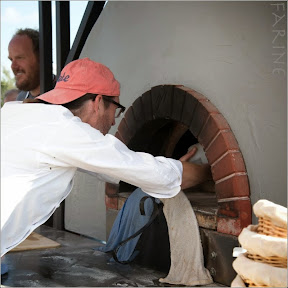Richard Miscovich is the author of From the Wood-Fired Oven: New and Traditional Techniques for Cooking and Baking with Fire, a book you definitely want to check out if you haven't read it yet, even if you don't have access to a WFO (as is my case). WFO owners will love to find out how to make optimal use of their oven's heat cycle and serious home bakers (or anyone wishing to bake bread at home) will treasure the wealth of information it offers on mixing, fermenting, dividing, proofing, etc. I like it that the book is never dogmatic and that the reader feels Richard's presence every step of the way. In the fall of 2011, I had the privilege to attend a BBGA class he taught at Johnson & Wales University in Providence, Rhode Island (where he is an associate professor at the College of the Culinary Arts) and I remember being awed both by his teaching and by his baking. Needless to say, when I discovered he would be doing both at the Grain Gathering, I made a beeline for his workshop (although I unfortunately had to leave smack in the middle to attend a talk on natural leavening). The linearity of Time is indeed the scourge of the human condition, isn't it?
I love to watch professionals score their proofed loaves. It always reminds me of dancing. The movement starts before the lame (or blade) even touches the dough. As Richard explains in his book, "Ideally, the motion is continuous, with the moving blade cutting neatly through the dough and continuing on its trajectory." Another baker I know phrased it differently but the idea is the same: "The lame has to hit the ground running!"
The bread was 40% whole wheat. As you can see from the images below, it turned out beautifully even though it started over-proofing a bit out in the warm air: if you let your dough over-ferment, the yeast uses up all the sugar and there will be no caramelization. So the proofing baskets had to be carried back all the way through the orchards to the retarder in the lab and brought back out again when the oven reached the right temperature. Fermentation does go more quickly with whole grain (the bread was 40% whole wheat), a wet dough (hydration was at 82-85%) and warmer temperatures.
Richard uses a garden mister to steam his oven. Someone asked how much steam to use. The answer: "You know there is enough steam when you can no longer keep your hand inside the oven to add more!" It is important to bake in a humid environment because the bread expands more, the score marks open more fully and you get a really good color with shine. If you bake at home and don't have a wood-fired oven, Richard recommends using a cast-iron combo cooker or to bake on a hearth stone or a sheet pan with a large metal bowl inverted over your loaf for the first twenty minutes.
For those of us who can't get to his classes, Richard mentioned he had a video out on Craftsy, Hand-made Sourdough - From starter to baked loaf. I haven't seen it yet.
Subscribe to:
Post Comments (Atom)




































Cara MC,
ReplyDeletetrovo il tuo reportage semplicemente strabiliante.... GRAZIE della generosa condivisione.
Sarebbe stato molto bello poter essere presente e poter sentire quei sensazionali profumi e deliziosi sapori.
Un abbraccio, a presto.
Anna
I can think of nothing less pleasurable than a life devoted to pleasure! Lovely...thanks for sharing, MC!
ReplyDelete